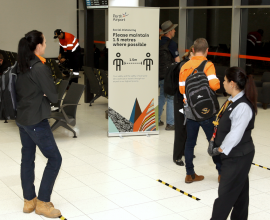Collaboration the key as Sydney Airport sets focus on the passenger
Sydney Airport chief executive Geoff Culbert has been consistently asked two questions since he started in the job in January.
“The first one is, ‘are you enjoying it?’” Culbert told a CAPA Centre for Aviation summit last week. “And the answer is unequivocally yes.”
The second question is what has surprised him. Ultimately, he says, the biggest surprise has been the fragmentation of the industry.
The relatively siloed approach to different aspects of the passenger journey means many parts of their trip from the couch to the gate are seen as individual processes, rather than part of one big experience.
It’s an issue he sees as a lost opportunity, and one that more collaboration between airports, airlines and other stakeholders could easily resolve.
“The thing is we all share the same common customer, which is the passenger, so we have a really strong anchor around which we can collaborate,” Culbert says.
“The priority of my leadership at Sydney Airport is to focus on the passenger as our end customers and to collaborate with those in the industry to deliver a really outstanding experience for our customers.
“There is really an enormous opportunity for us to work together in a significant way.”
Having joined Sydney Airport after leading GE’s Australia and New Zealand arm, Culbert already “had one foot in the industry” through the company’s aviation business.
He says one of the surprises of the new job has been the passion that exists within the industry.
From his team running the nation’s busiest airport, through to their airline and other partners, the enthusiasm for aviation runs deep.
While that passion has fuelled good examples of collaboration across the industry, Culbert believes a more concerted effort could unlock even greater outcomes.
He points to the airport’s current partnership with Qantas to deliver automated check-in and bag drop services.
Modelling for the pilot project shows it will reduce congestion and move passengers through the terminal faster, particularly during peak times.
And the technology – which “democratises check-in” to give all passengers a smooth and easy experience – is being noticed, with Culbert highlighting the potential for a consistent approach across the terminal.
“We really think this is the future in terms of providing a better experience for our customers as they go through the check-in experience,” Culbert says.
“I’ve had a number of airlines approach me that say we’d like to do something like that ourselves and the answer is well, we’d love to do that with you.”
Technology is one area where Culbert sees significant opportunity for airports and airlines across the country to leverage their collective buying power.
“Nearly every airport in Australia and around the world is running a biometrics program at the moment and they’re all doing it with a slightly different technology,” he says.
“I just ask myself as someone from outside of the that industry, why is that? Why are we all working on a different form of the same technology? Why aren’t we getting together and collaborating around the technology and using our size, our scale and our purchasing power to come up with a common platform we all benefit from?”
Looking beyond the airport boundary, he cites access to the airport as an important area of focus.
Acknowledging congestion is an issue, he says the airport’s own road improvements, along with its work to promote the train, ridesharing services and a range of parking options, is part of the solution.
Discussions with the NSW Government on the Gateway project are well advanced, with Culbert noting that a future journey to the airport from Seaforth, Parramatta or Castle Hill could potentially mean no traffic lights.
Most important, he says, is developing a solution that is sustainable and will reduce congestion around the airport – not just for passengers, but the 50 per cent of motorists travelling past the airport on their way to other destinations.
In the meantime, helping passengers navigate their journey is something Culbert believes collaboration with airlines could achieve.
A simple app that provides alerts and notifications based on a passenger’s travel plans could provide personalised information on travel time, transport options and changing traffic conditions ahead of their journey to the airport.
“We don’t do that at the airport because we don’t have the customer information,” Culbert says.
“We have the traffic information, but we’re not connecting and we’re missing an opportunity in this regard.”
However, the airport has seized new opportunities at its terminals, where recently completed refreshes of T1 International and T2 Domestic terminals have been well received. Changes are also expected at T3 Domestic when the airport takes operational control of that terminal next year.
Better wayfinding, charging stations and bathroom amenities were installed at T1 and T2 in response to customer feedback, and subsequent customer surveys have shown strong improvements.
But it’s the world-class dining options and new shopping precincts that have really captured passengers’ attention, and Culbert says they have added to the travel experience.
“I want to bring a little bit of glamour and excitement back to travel because travel is an emotional experience,” he says.
That excitement will soon be translated into an upgraded arrivals experience at T1, that Culbert expects will make a big impression for international tourists arriving in Australia and instil a sense of pride in locals returning home.
Ultimately, Culbert says there is much to look forward to, with the airport projecting 65.6 million passengers by 2039 – a growth rate of about a million passengers a year.
The challenge, he says, is getting the collaboration right to support that growth and unlock greater efficiencies for both the airport and airlines.
“It is a massive opportunity for everyone and we all stand to benefit if we work together.”





